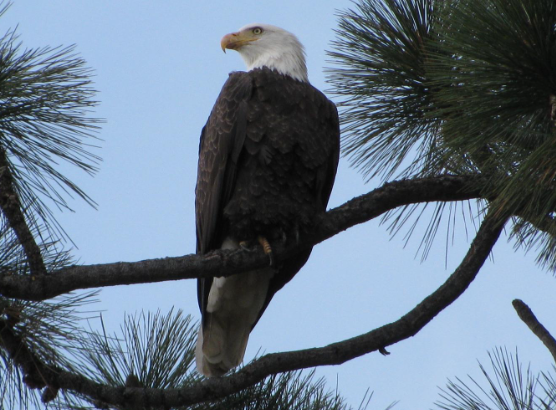Wintering Eagles

Courtesy Pixabay
By Donda Hartsfield
Majestic, free, sacred, fierce, and faithful are words that could be used to describe North America’s most distinguished raptor, the Bald eagle, Haliaeetus leucocephalus. Today we are on a mission with Uinta class (upper elementary) to spot Bald eagles that are wintering around Farmington Bay near the Great Salt Lake and the Eccles Wildlife Education Center. There is just one problem with today’s plans. It is raining and expected to stay that way most of the day. Bald eagles are well suited for cold northern climates with their highly insulating feathers, however they migrate south during the winter so they can continue to access their favorite food of fish in areas where the rivers are not yet frozen over. This is why we see so many of them in Utah in the winter and why the month of February is considered to be Bald Eagle month. Bald eagles can often be sighted around Farmington Bay and other brackish waters near the edge of the Great Salt Lake as well as many of the surrounding rivers and reservoirs.
Our first Bald eagle sighting takes place on a lone dead tree branch in the middle of a wetland surrounded by tall grasses and reeds. Through binoculars we were able to see the distinguishing white head and razor-sharp, yellow beak. Enthusiastic gasps from the students such as, “That is so cool!” and “He is so beautiful!” echo throughout the van. Heavy cloud cover extends out across the sky, as phragmites stare back at us through the mist.

Continuing with our exploration of the area, we drove down the road and looked out over the expanse of the wetland towards the west where we spotted some movement in the distance that looked suspiciously large. This was our second sighting of a bald eagle in flight which we tracked through binoculars for several minutes. It hovered low over the landscape, occasionally dipping down and disappearing among the tall grasses. Then it would later reappear continuing to fly low, as though it were scouring the landscape for lunch. There was another eagle participating in the same behavior nearby. Everyone enjoyed the challenge of tracking the aerial masters as we wondered what they were doing when they slipped into the bushes unseen for many minutes at a time. Bald eagles prefer to eat fish whenever possible, however they will also eat other birds, small mammals, reptiles and carrion. Sounds of seagulls, red winged blackbirds, ducks, and geese filled the wide-open skies of the wetland.

Yellow eyes, beak and feet as adults, these large birds of prey develop their famous white feathers on their heads and tails once they reach adulthood, around four years old. As juveniles, their feathers are mostly brown and they are often mistaken for Golden eagles. Their call to each other is distinct, but not necessarily what many people presume. The classic trailing cry of a raptor in flight that is often associated with a Bald eagle, actually belongs to the Red-tailed hawk (popularized by movies). Bald eagles make many different sounds, however the most distinguishing call is a high pitched, quick series of shrill chirps.
Bald eagles are typically monogamous and tend to return to the same nest each year in their nesting range. Nests can typically be up to 5 feet across and 3 feet deep or larger, making them the largest nest built by any bird in North America.

from the window of the van as we were leaving the wetland.
While gazing across the water, we saw many ducks, seagulls, blue herons and Tundra swans. The swans appeared as large, white ovals floating on the surface due to tucking their heads into their bodies as they rest. We also saw kestrels perched on telephone lines and Northern harriers flying gracefully. As we are tracking the harrier, one student comments, “I thought bird watching was going to be boring, but it’s actually pretty awesome.”
Just as we are heading out, we notice a bald eagle perched on a tree in full view about 15 yards away. This beautiful adult is calmly looking out over his world and with the aid of binoculars, students can even see into his eyes. The eagle patiently observes us looking on, but does not seem to perceive us as a threat. It occasionally preens its feathers, but mostly sits perfectly still, seeming content and at peace with the moment. Everyone seems to be comfortable being present with the wetland and this magnificent creature.

Another lesson learned from nature: There is a time and a place to exert one’s effort and energy, and there is a time to rest and to be content with what you have wherever you are. For, it is in the balance of these two realms of action and non-action that we can find our sense of inner peace and satisfaction with life. Perhaps we can try to “perch” with contentment more often, as inspired by the bald eagle.